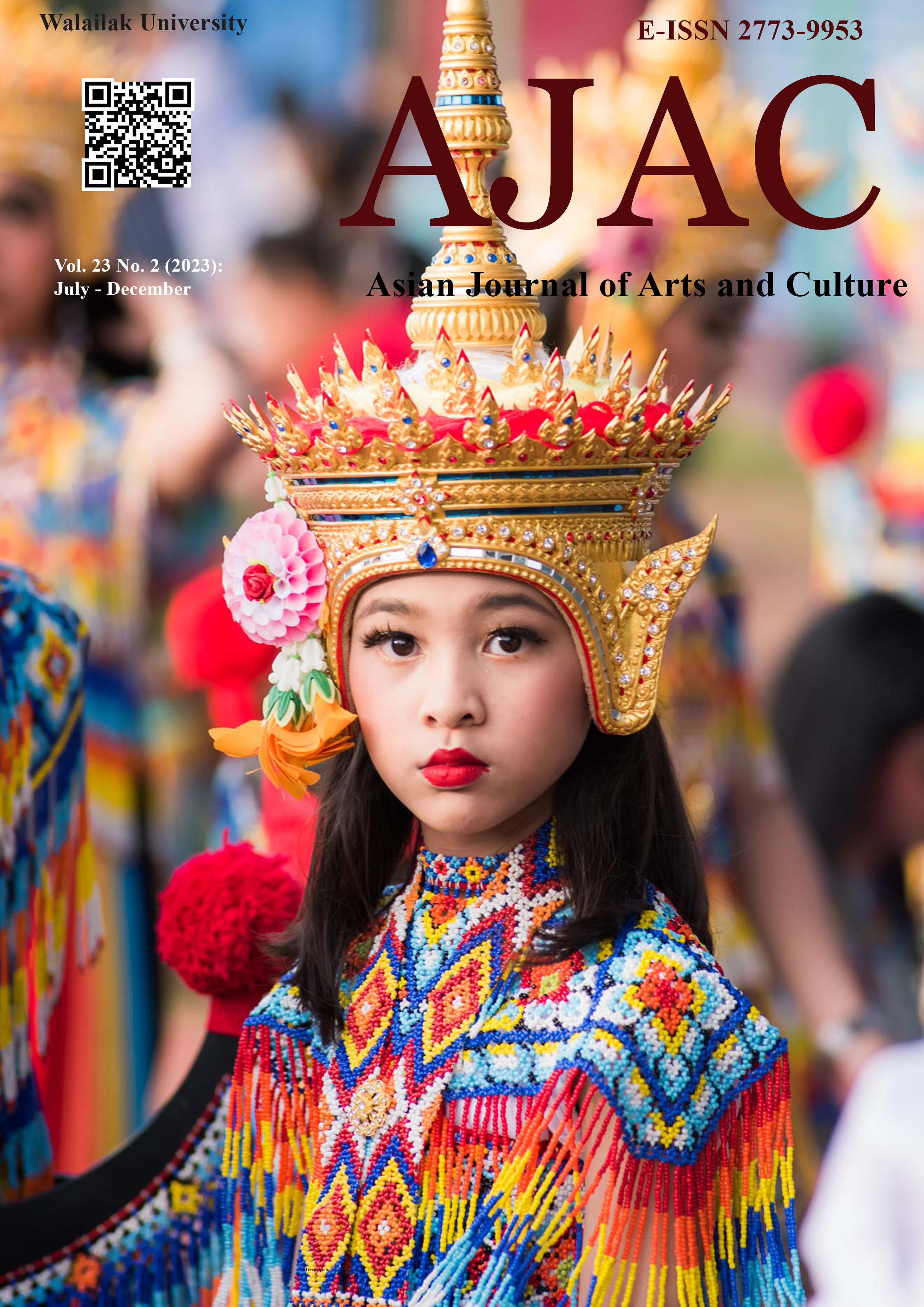Exploring Jiarong Tibetan's Diverse Religious Culture through the Intangible Cultural Heritage of Buzha Drama
Main Article Content
Abstract
The Buzha drama of the Garzê Tibetan people is a unique “ritual dance” performed periodically in various religious settings. This form of performance, which falls between theater and dance, reflects the diverse cultural and belief systems of the local people and has been listed as an intangible cultural heritage for protection in recent years. Tribal organizations integrate various religious and cultural forms, including folk beliefs, Bon, Tibetan Buddhism, local customs, and regional knowledge into folk song and dance, transforming them into psychological customs and ethnic emotions, penetrating cultural elements. This article takes an anthropological perspective and examines the relationship between the artistic representation of the Buzha drama and the region's life, spiritual beliefs, and ethnic identity through prop making, ritual procedures, and dance content. The article also explores the characteristics and values of the diverse religious culture of the Garzê Tibetan people.
Article Details

This work is licensed under a Creative Commons Attribution-NonCommercial-NoDerivatives 4.0 International License.
© 2018 by Asian Journal of Arts and Culture, Walailak University. All rights reserved.
References
Aba Prefecture Local Chronicles Office (2020). The CCTV Documentary Series "Chinese Documentary Heritage - Xiaojin Edition" was Aired with Stunning Impact!. [in Chinese] Retrieved from http://scsqw.cn/gzdt/qsfzdt/sxfzdt/content_42211
Bo, W. (2020). Study on Dege Tibetan Opera of intangible cultural heritage. Academic Journal ofHumanities & Social Sciences, 3(7), 188-195.
Danzeng, J. (2011). In the Heartland of the Eastern Queendom: Marginalities and Identities on the HanTibetan Border. Boston, USA: Boston University.
Flew, T. (2020). Globalization, neo-globalization and post-globalization: The challenge of populism and the return of the national. Global Media and Communication, 16(1), 19-39.
Gleason, P. (2019). Speaking of diversity: Language and ethnicity in twentieth-century America. Baltimore,USA: Johns Hopkins University.
He, W. W. (2017). Comparative study of Qiang Ethnic Diaolou Architecture and Garong Tibetan Diaolou Architecture. Chinese Ethnic Art 17(3), 10-21. [in Chinese]
Juergensmeyer, M. (2019). Religious nationalism in a global world. Religions, 10(2), 1-8.
Kim, S., Whitford, M., & Arcodia, C. (2021). Development of intangible cultural heritage as a sustainable tourism resource: The intangible cultural heritage practitioners’ perspectives. In Authenticity and Authentication of Heritage. (pp. 34-47). Routledge.
Kolas, A. (2005). On the Margins of Tibet: Cultural Survival on the Sino-Tibetan Frontier. Seattle, USA: University of Washington Press.
Li, H. & Zhang, J. (2019). Conceptual structure of kinship terms in the Garong Tibetan Tribe: A comparative study with the Naxi, Mosuo, Yi, and Bai ethnic groups. Journal of Guiyang College: Social Sciences Edition, 14(4), 9-16. [in Chinese]
Li, Q. (2010). On the relationship between Garong, Jialiangyi, Ranhuang, and the Guorén: A discussion on the ethnic origins of the Garong Tibetan Tribe. Journal of Sichuan University for Nationalities, 19(4), 1-6. [in Chinese]
Liu, X., & Li, M. (2020). Safeguarding intangible cultural heritage to promote mental healthcare in China: Challenges to maintaining the sustainability of safeguarding efforts. International Journal of Social Psychiatry, 66(3), 311-313.
Pedersen, P. (2014). Nature, religion and cultural identity: The religious environmentalist paradigm. In Asian Perceptions of Nature (pp. 258-276). London, UK: Routledge.
Peng, Z. Y., & Chen, Y. T. (2018). Investigation on the current status of the protection of the ruins of Tibetan chieftain's manor in Northwest Western Sichuan. Journal of Tibet Nationalities University: Philosophy and Social Sciences Edition, 39(5), 90-98. [in Chinese]
Sai, C. J. (2017). Historical "Narration" and historical analysis: Reading 'compilation of research materials on Garong Tibetan Tribe'. Northwestern Ethnic Studies 17(2), 61-70 [in Chinese]
Su, W. (2017). Sacred and secular garong: Reading notes on 'A clear mirror of Garong Tibetan history'. Northwestern Ethnic Studies, 15(2), 26-35. [in Chinese]
Sunshine over Tibet (2018). "Opera" on the Plateau: Exploring the Buzka Drama in Dawazi Village, Hannon Township, Xiaojin County.[in Chinese] Retrieved from https://zangdiyg.com/Home/Article/detail/id/7759.html
Travel Guide (2023). Origin Chapter: Tracing the Historical Origins of Jiarong, Exploring the Past and Present of a Fascinating Ethnic Group. [in Chinese] Retrieved from https://www.sohu.com/a/646996133_121336953
Tu, J. J., Chen, Y., Ye, Y. Q., & Chen, G. J. (2005). The upper min river basin: A key ethno-cultural corridor in China. Mountain Research and Development, 25(1), 25-29.
Xu, F. (2022). Investigation and adaptability analysis of Traditional Jiarong Tibetan Dwellings in Aba: A case study of Zhibo Village. Open Access Library Journal, 9(8), 1-10.
Ye, N., & Si, Q. (2021). Exploring the multicultural elements of the Garong Tibetan Tribe through Garong Proverbs: A case study of the miaoluo four ocal dialects. Journal of Ethnology, 17(2), 71-76. [in Chinese]
Yi, W, Zhao, Y. L, & Zhong, R. (2018). A Geographic Survey of the Garong Tibetan Clothing Culture: Between Ethnicity and Modernity. Tropical Geomorphology 18(2), 11-19. [in Chinese]
Zeng, X. J. (2017). Compilation of old local chronicles in the Garong Tibetan region. Tibet Studies, 17(1), 71-80. [in Chinese]
Zeng, X. J. (2021). The origin and rise of Jinchuan Tusi: An interpretation of the name 'Jinchuan'. Tibetan Studies, 19(1), 35-42. [in Chinese]


